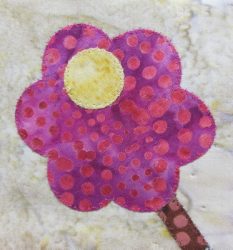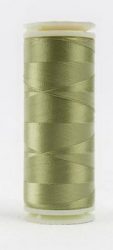Have you ever noticed just how many threads are available for us to use. Before I just jump in talking about Invisafil thread, let’s be sure we all understand how to tell what the thread you have selected is going to do. Thread is assigned a “weight”. To me, it’s just a number. All I have to remember is that the lower the number the thicker the thread and the higher the number the thinner the thread. Write it down if you have to because it is so important to your success in working with different threads. We stock threads for the sewing machine that range from 12 to 100, with 12 being the thickest that will easily go thru a Topstitch needle and 100 being the very thinnest available.
In one of my previous posts I talked about 12 wt thread and how to set your machine for success. That’s the really fun thread because your stitches are so impressive, but there are times when you need a much thinner thread. In fact, the thinner the better.
This time we are going to talk about a Invisafil Thread from Wonderfil Thread Company. This little thread is a 100 weight polyester thread with a matte finish. We prefer this matte finish thread to the invisible threads that are available only in clear and dark. Those threads always have a little shine to them. We have seen it suggested to use a cotton thread in the bobbin. With Invisafil thread you will use the same thread on the top and on the bobbin.
Let me give you my little “cheat sheet” for the set up with Invisafil Thread:
- Use invisafil in the top and the bobbin
- The thread is so thin, you might want to loosen your top thesion by a number (ie. 4 to 3)
- For applique, use a 70 Microtex needle as you don’t need to punch a big hole for this thin thread.
- For quilting, use an 80 Microtex needle to easily punch thru the batting.
We use Invisafil with raw edge applique.
The setting on my machine is just a normal zig zag stitch with a width of about 1.5 and a length of about 1.2. The trick when doing this stitch is to keep the stitching on the fabric. Ideally, it would be half on and half off the edge. If you move totally on the fabric, you will be fine, but if you move totally off the fabric, you will see the stitching and should take it out.
Just a hint about fusing your fabric for raw edge applique. When we get a complaint about skipped stitches or a gummy needle, we always ask about the length of time for the fusing. Most of our customers with problems didn’t know that there are specific directions and times for each of the fusibles. So before you begin working on your project, be sure you know how to properly use the fusible you have chosen. This will help eliminate these two issues.
We have also used Invisail for free-motion quilting as you won’t see your stitches. This is a big plus to those of us who are not consistent in the stitch length. If you like the “micro” quilting for detail, then this thread is just great for that.
We hope you will give Invisafil a try for applique, free motion stitching or other detail work when you don’t want the thread to show. One of our gals loves this thread for hand applique as it truly doesn’t show. It isn’t nearly as slippery as silk thread and thinner than cotton. You can find Invisafil thread on our website. There are 60 colors, but you only have to be in the ballpark to find a shade that will work for your project. You can see them all at Invisafil Thread .

